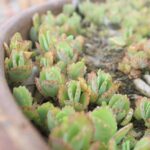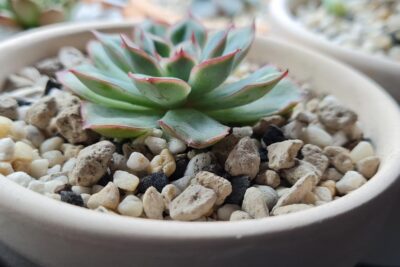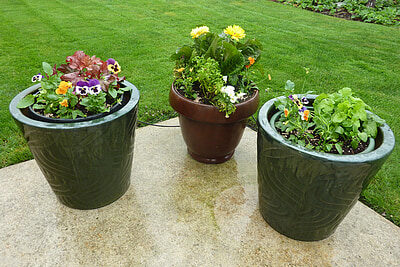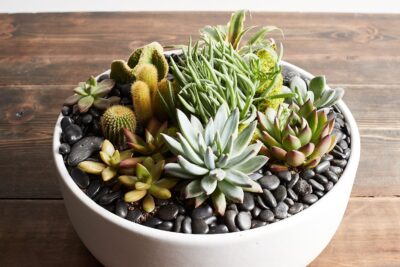
Best Practices for Repotting Succulents with Rock Drainage

Succulents have become increasingly popular in recent years due to their unique and low-maintenance nature. These plants, known for their ability to store water in their leaves and stems, come in various shapes, sizes, and colors, making them a favorite among plant enthusiasts and beginners alike. One important aspect of caring for succulents is repotting, which involves transferring the plant to a new container with fresh soil. This process is crucial for the health and growth of succulents, as it allows them to have adequate space and nutrients to thrive.
We will discuss the best practices for repotting succulents with rock drainage. We will explore the benefits of using rocks as drainage material, such as preventing waterlogged soil and promoting better root health. Additionally, we will provide step-by-step instructions on how to repot succulents, including choosing the right container, preparing the soil mixture, and properly removing and replanting the succulent. Whether you are a seasoned succulent enthusiast or new to the world of succulents, this article will provide you with valuable tips and techniques to ensure successful repotting and long-term plant health.
- Choose a well-draining potting mix specifically formulated for succulents
- Use a pot with drainage holes to prevent waterlogged soil
- Place a layer of small rocks or gravel at the bottom of the pot to enhance drainage
- Gently remove the succulent from its current pot, being careful not to damage the roots
- Examine the roots and trim any roots that are rotting or damaged
- Place the succulent in the new pot and fill in the gaps with fresh potting mix
- Press the soil gently around the roots to secure the succulent in place
- Water the succulent thoroughly but avoid overwatering
- Allow the soil to dry out completely between waterings
- Place the potted succulent in a location with bright, indirect sunlight
- Avoid exposing the succulent to extreme temperatures or drafts
- Monitor the succulent for signs of stress or diseases and take appropriate action if necessary
- Enjoy your healthy and thriving repotted succulent!
- Frequently Asked Questions
Choose a well-draining potting mix specifically formulated for succulents
When it comes to repotting succulents, choosing the right potting mix is crucial for their overall health and growth. Succulents prefer well-draining soil that allows excess water to flow out easily, preventing root rot and other moisture-related issues.
Opt for a potting mix specifically formulated for succulents. These mixes are usually a combination of regular potting soil, coarse sand, and perlite or pumice. The coarse sand helps to improve drainage, while perlite or pumice aids in retaining some moisture without causing waterlogged roots.
Tip: Avoid using regular garden soil or heavy potting mixes as they tend to hold too much moisture, leading to root rot and ultimately harming your succulents.
Use a pot with drainage holes to prevent waterlogged soil
When it comes to repotting succulents, one of the most important considerations is to use a pot with drainage holes. Succulents, with their thick leaves and water-storing capabilities, are prone to root rot if their roots are constantly sitting in water. Therefore, it is crucial to provide adequate drainage for these plants.
 Uncover the Thrill: Perfect Filler and Spiller Succulents!
Uncover the Thrill: Perfect Filler and Spiller Succulents!By using a pot with drainage holes, excess water can easily escape, preventing waterlogged soil. This allows the roots to receive the right amount of moisture without becoming saturated, promoting better overall plant health and growth.
Additionally, when choosing a pot, it is essential to select one that is appropriately sized for your succulent. A pot that is too large can retain excess moisture, increasing the risk of root rot. On the other hand, a pot that is too small may restrict the growth and development of the plant. So, finding the right pot size is crucial for maintaining optimal conditions for your succulent.
Remember, when repotting your succulent, always ensure that the new pot has drainage holes and is of the appropriate size to create the best conditions for your plant.
Place a layer of small rocks or gravel at the bottom of the pot to enhance drainage
When it comes to repotting succulents, ensuring proper drainage is essential for their health and well-being. One way to achieve this is by placing a layer of small rocks or gravel at the bottom of the pot.
The purpose of this layer is to create a barrier between the succulent's roots and the excess water that may accumulate in the pot. This barrier allows the water to freely flow through the soil, preventing the roots from becoming waterlogged and potentially rotting.
Furthermore, the layer of rocks or gravel also helps to prevent the soil from compacting over time. This allows for better aeration and root growth, as compacted soil can hinder the succulent's ability to absorb water and nutrients.
 Best Places to Send Succulents as a Thoughtful Gift
Best Places to Send Succulents as a Thoughtful GiftTo create this drainage layer, start by selecting small rocks or gravel that are about the size of a pea. Place a generous amount evenly across the bottom of the pot, covering about 1-2 inches of the pot's depth. Ensure that the layer is relatively uniform and does not have any large gaps.
Important: It's crucial to note that the layer of rocks or gravel should not take up too much space in the pot. Aim for about 10-20% of the pot's total height. This ensures that there is still enough room for an adequate amount of soil for the succulent's roots to grow and spread.
Once the drainage layer is in place, you can proceed with adding the potting mix on top. Use a well-draining succulent or cactus soil mix that is specifically formulated to provide the necessary nutrients while allowing excess water to escape easily.
Tip: If you don't have small rocks or gravel on hand, you can also use perlite or pumice as an alternative. These lightweight materials serve the same purpose and can be easily mixed into the soil for improved drainage.
Placing a layer of small rocks or gravel at the bottom of the pot is a best practice for repotting succulents. It enhances drainage, prevents waterlogging, and promotes healthy root growth. Remember to maintain the appropriate ratio of drainage layer to soil to ensure optimal conditions for your succulents to thrive.
Gently remove the succulent from its current pot, being careful not to damage the roots
When it comes to repotting succulents, it is important to handle them with care. Start by gently removing the succulent from its current pot, making sure not to damage its delicate roots. This step is crucial to ensure the health and longevity of your succulent.
Prepare a well-draining potting mix
Next, prepare a well-draining potting mix for your succulent. Succulents thrive in well-draining soil, as it helps prevent root rot and other moisture-related issues. You can create a suitable potting mix by combining equal parts of cactus soil, perlite, and coarse sand.
 Charming Miniature Succulents: Cute and Compact Plants in Pots!
Charming Miniature Succulents: Cute and Compact Plants in Pots!Choose a pot with proper drainage holes
Choosing the right pot for your succulent is essential. Opt for a pot that has proper drainage holes to allow excess water to flow out. This prevents water from accumulating at the bottom and causing root rot. Additionally, ensure that the pot is slightly larger than the current one to allow room for growth.
Place a layer of rocks at the bottom of the pot
To further enhance the drainage in your succulent's new pot, place a layer of rocks at the bottom. This creates a reservoir for excess water to collect, keeping the roots from sitting in water. The rocks also add a decorative touch to your potted succulent.
Position the succulent in the pot and fill with potting mix
Now, carefully position your succulent in the pot, making sure the roots are spread out. Gently fill the remaining space with the prepared potting mix, ensuring that the roots are covered but not buried too deeply. Use your fingers to lightly firm the soil around the base of the succulent.
Water sparingly and gradually increase as needed
After repotting your succulent, it is important to water it sparingly. Overwatering can lead to root rot and other issues. Gradually increase the amount of water as needed, allowing the soil to dry out between waterings. Remember, succulents are adapted to survive in arid conditions and do not require frequent watering.
Place in a well-lit area and monitor for signs of stress
Finally, place your repotted succulent in a well-lit area, preferably near a window with indirect sunlight. Succulents thrive in bright light but can get sunburned if exposed to direct sunlight for prolonged periods. Monitor your succulent for any signs of stress, such as wilting or discoloration, and adjust its placement accordingly.
By following these best practices for repotting succulents with rock drainage, you can ensure the health and vitality of your beloved plants. Remember to handle them with care, provide proper drainage, and monitor their watering needs. With a little attention, your succulents will continue to thrive and beautify your space.
Examine the roots and trim any roots that are rotting or damaged
 Does the Size of the Pot Affect the Growth of Succulents?
Does the Size of the Pot Affect the Growth of Succulents?When repotting your succulents, it is crucial to start by examining the roots. Carefully remove the plant from its current pot and gently shake off any excess soil. Take a close look at the roots and identify any that are rotting or damaged.
Tip: Rotting roots are usually brown or black in color and feel mushy to the touch. Trim these roots using a clean pair of scissors or pruning shears, ensuring you remove all the affected areas. This will help prevent the spread of rot and encourage healthy root growth.
Place the succulent in the new pot and fill in the gaps with fresh potting mix
When repotting your succulent, it's important to choose the right potting mix. Succulents thrive in well-draining soil, so opt for a mix specifically formulated for succulents or cacti. This will prevent waterlogging and root rot, ensuring the health of your plant.
Once you have the right potting mix, gently remove the succulent from its old pot. Be careful not to damage the roots in the process. Place the succulent in the new pot, ensuring that it is centered and at the desired depth.
Next, it's time to fill in the gaps around the succulent with fresh potting mix. Use a spoon or your fingers to carefully add the mix, ensuring that there are no air pockets or gaps left. Press the soil gently to secure the succulent in place.
While filling in the gaps, make sure not to bury the succulent too deeply. The base of the plant should be slightly above the soil level to prevent rotting.
 Can You Mix Different Types of Succulents in One Pot?
Can You Mix Different Types of Succulents in One Pot?It's also important to note that different succulents have varying root systems. Some have shallow roots, while others have deeper ones. Adjust the potting mix and depth accordingly to accommodate the specific needs of your succulent.
Pro Tip: To enhance drainage further, you can add a layer of rocks or pebbles at the bottom of the pot before adding the potting mix. This will create a reservoir for excess water to drain into, preventing waterlogging and promoting healthy root growth.
Once you have filled in the gaps and ensured the succulent is secure, give it a gentle watering. Be careful not to overwater, as succulents are drought-tolerant plants and can easily succumb to root rot if sitting in waterlogged soil.
Now that your succulent is comfortably settled in its new pot with fresh potting mix, find a suitable spot for it where it can receive adequate sunlight and continue to thrive.
Press the soil gently around the roots to secure the succulent in place
When repotting succulents, it's important to ensure proper drainage to prevent root rot. One of the best practices is to use rock drainage in the potting mix. Rock drainage helps excess water to flow out of the pot, keeping the soil well-drained and the succulent roots healthy.
Here are some steps to follow when repotting your succulents with rock drainage:
 DIY Succulent Terrarium: A Step-by-Step Guide to Stunning Home Decor
DIY Succulent Terrarium: A Step-by-Step Guide to Stunning Home Decor- Select the right pot: Choose a pot with drainage holes at the bottom. This allows water to escape and prevents it from pooling around the roots. A pot with a saucer is also ideal as it catches the excess water.
- Prepare the potting mix: Mix equal parts of well-draining soil and coarse sand or perlite. This creates a light and airy blend that promotes good drainage. Add a handful of small rocks or pebbles to the bottom of the pot.
- Remove the succulent from its current pot: Gently tap the sides of the pot to loosen the soil. Carefully lift the succulent out, holding it by the base of the plant to avoid damaging the delicate leaves or stems.
- Inspect the roots: Check the roots for any signs of rot or pests. Trim away any damaged or dead roots using clean, sharp scissors or pruning shears.
- Place the succulent in the new pot: Position the succulent in the center of the pot, ensuring that the base of the plant is slightly above the rim. This prevents water from flowing into the crown of the plant and causing rot.
- Fill in the gaps with the potting mix: Gently pour the potting mix around the roots, gradually filling in the gaps. Press the soil gently around the roots to secure the succulent in place.
- Water sparingly: After repotting, give the succulent a light watering. Be careful not to overwater, as succulents are prone to root rot. Allow the soil to dry out completely before watering again.
By following these best practices for repotting succulents with rock drainage, you can ensure that your succulents thrive in their new pots. Remember to check the moisture levels regularly and adjust your watering schedule accordingly to keep your succulents happy and healthy!
Water the succulent thoroughly but avoid overwatering
When it comes to repotting succulents, one of the most important things to keep in mind is proper watering. Succulents have unique water requirements, and it's essential to strike a balance between providing enough water and avoiding overwatering.
Before you begin the repotting process, make sure to water your succulent thoroughly. This ensures that the plant is well-hydrated and prepared for the stress of being replanted. However, be cautious not to overwater, as excessive moisture can lead to root rot and other issues.
When watering your succulent, it's best to use the "soak and dry" method. This means thoroughly drenching the soil until water drains out from the bottom of the pot. Allow the soil to dry completely before watering again. This method mimics the succulent's natural habitat, where it experiences periods of intense rainfall followed by long periods of drought.
By following this watering technique, you ensure that the succulent's roots receive adequate moisture while preventing the risk of rot. Remember, succulents are adapted to survive in arid conditions, so they're more tolerant of underwatering than overwatering.
Choose a well-draining potting mix
The choice of potting mix is crucial when repotting succulents. The ideal mix should be well-draining, allowing excess water to flow out easily. This prevents water from sitting in the pot, which can lead to root rot and other problems.
An excellent option for succulent potting mix is a blend of regular potting soil, coarse sand, and perlite or pumice. This combination ensures proper drainage while providing enough nutrients for the succulent to thrive.
 Discover the Best Online Shops for Mini Succulents in Pots
Discover the Best Online Shops for Mini Succulents in PotsIt's important to avoid using regular garden soil or heavy clay-based mixes, as they tend to retain moisture for longer periods. This can suffocate the succulent's roots and cause them to rot. Stick to specialized succulent potting mixes or create your own well-draining blend for optimal results.
Consider adding rock drainage to the pot
In addition to using a well-draining potting mix, incorporating rock drainage into the pot can further improve the succulent's overall health. The rocks act as an additional layer of defense against waterlogging by creating space for excess water to escape.
To add rock drainage to your succulent pot, start by placing a layer of small pebbles or rocks at the bottom. This layer should be about an inch thick or enough to cover the drainage holes. The rocks create a barrier that prevents the soil from clogging the drainage holes while allowing water to flow freely.
However, it's vital to remember that the rock drainage layer should not be too thick, as it can impede proper root growth. Aim for a sufficient layer that promotes drainage without compromising the space available for the succulent's roots.
Remember, proper watering and a well-draining potting mix are essential for the health and longevity of your succulents. By following these best practices for repotting succulents with rock drainage, you can ensure that your plants thrive in their new home.
Allow the soil to dry out completely between waterings
One of the most important best practices for repotting succulents with rock drainage is to allow the soil to dry out completely between waterings. Succulents are known for their ability to store water in their leaves and stems, making them highly drought-tolerant plants. Therefore, overwatering can lead to root rot and other problems.
 Captivating Succulent Beauty: A Photography Journey
Captivating Succulent Beauty: A Photography JourneyWhen repotting succulents, it's crucial to use well-draining soil that allows excess water to flow out easily. Adding rocks or pebbles at the bottom of the pot can further enhance drainage. This ensures that water doesn't accumulate at the roots, preventing rot and providing optimal growing conditions for your succulents.
Succulents thrive in arid conditions, where the soil is allowed to dry out in between waterings. This mimics their natural habitat and promotes healthy root growth. By allowing the soil to dry out completely, you prevent the risk of overwatering and create an environment where your succulents can thrive.
When watering succulents, it's important to give them a thorough soak rather than lightly misting them. This encourages deep root growth as the roots will grow towards the water source. However, it's crucial to wait until the soil is completely dry before watering again.
Remember, different succulent species may have varying water requirements, so it's essential to research the specific needs of your succulents. Some succulents may require more frequent watering than others, but the general principle of allowing the soil to dry out between waterings still applies.
Key points to remember:
- Use well-draining soil to prevent water accumulation at the roots.
- Add rocks or pebbles at the bottom of the pot to enhance drainage.
- Allow the soil to dry out completely between waterings.
- Water thoroughly but wait until the soil is dry before watering again.
- Research the specific water requirements of your succulents.
By following these best practices for repotting succulents with rock drainage, you can ensure that your succulents thrive and stay healthy. Remember, succulents are resilient plants, but they do require proper care to flourish in their new pots. So, take your time, be mindful of their water needs, and enjoy the beauty of your repotted succulents!
Place the potted succulent in a location with bright, indirect sunlight
 DIY Succulent Terrariums: Simple Steps for Stunning Results
DIY Succulent Terrariums: Simple Steps for Stunning ResultsWhen it comes to caring for succulents, proper placement is essential. Succulents thrive in bright, indirect sunlight, so it's crucial to find the right spot for your potted succulent. Ideally, place it near a window where it can receive a few hours of sunlight each day. However, be cautious of exposing it to direct sunlight, as it can scorch the leaves and cause damage to the plant.
Additionally, if you notice that your succulent is stretching or leaning towards one side, it's a sign that it's not receiving enough light. In this case, consider moving it closer to a window or providing supplemental artificial light to promote healthy growth.
Choose a well-draining potting mix
When repotting succulents, it's crucial to use a well-draining potting mix to prevent waterlogged roots. A suitable mix for succulents usually consists of a combination of regular potting soil, perlite, and coarse sand. This blend provides excellent drainage and helps prevent the roots from sitting in water, which can lead to root rot and other issues.
If you are unsure about the right mix, you can find pre-made succulent potting mixes available at most gardening stores. These mixes are specifically designed to meet the needs of succulents, ensuring optimal drainage and aeration for their roots.
Prepare the new pot with rock drainage
One of the best practices when repotting succulents is to add a layer of rock drainage at the bottom of the pot. This layer helps create a buffer between the potting mix and the drainage holes, preventing the soil from clogging the holes and improving overall drainage.
To create a rock drainage layer, start by placing a few small rocks or pebbles at the bottom of the pot. The layer should be about an inch thick, depending on the size of the pot. This layer will allow excess water to drain freely and prevent water from pooling at the bottom of the pot, which can lead to root rot.
Remember to choose rocks that are clean and free from any chemicals or contaminants that could harm your succulent. Avoid using large rocks that may obstruct the drainage holes or create an uneven surface for the roots.
 Moss and Succulents: A Unique Aesthetic for Stunning Décor
Moss and Succulents: A Unique Aesthetic for Stunning DécorGently remove the succulent from its current pot
Before repotting your succulent, it's important to gently remove it from its current pot. Start by carefully loosening the soil around the edges of the pot using your fingers or a plant tool. Avoid pulling or yanking the succulent, as this can damage the roots.
Once the soil is loosened, carefully turn the pot upside down while supporting the base of the plant. Tap the bottom of the pot or lightly squeeze the sides to release the succulent and its root ball from the pot. Be patient and take your time to ensure you don't cause any harm to the plant.
If the succulent is tightly rooted or the soil is sticking to the roots, you can gently massage the root ball to separate the soil. However, be careful not to remove too much soil or damage the delicate roots in the process.
Pro tip: If the root ball is too compacted or the roots are circling around, you can use a clean pair of scissors or pruning shears to make small cuts or trim the roots slightly. This will encourage the growth of new roots and help the succulent establish itself in its new pot.
Avoid exposing the succulent to extreme temperatures or drafts
When repotting succulents, it is crucial to ensure that they are not exposed to extreme temperatures or drafts. These plants thrive in warm and arid conditions, so sudden changes in temperature can be detrimental to their health.
To avoid subjecting your succulents to extreme temperatures, it is recommended to repot them indoors or in a sheltered area. This will provide them with a stable environment and protect them from any sudden temperature fluctuations.
Additionally, it is important to avoid placing succulents near drafty areas such as open windows or doors. Drafts can cause rapid temperature changes and dry out the plants, leading to stress and potential damage. Keep your succulents away from these areas to ensure their well-being.
Monitor the succulent for signs of stress or diseases and take appropriate action if necessary
When repotting succulents with rock drainage, it is important to closely monitor the plants for any signs of stress or diseases. Succulents are generally hardy plants, but they can still be susceptible to certain issues that may arise during the repotting process.
One of the key signs to look out for is wilting or drooping leaves. This can indicate that the succulent is not receiving enough water or is experiencing root rot. If you notice this, it is important to adjust your watering schedule accordingly or take measures to improve the drainage in the new pot.
Additionally, keep an eye out for any discoloration or abnormal growth patterns. Brown or black spots on the leaves may indicate a fungal or bacterial infection, while yellowing leaves can be a sign of overwatering. If you observe any of these symptoms, it is crucial to address them promptly to prevent further damage to the plant.
It is also advisable to inspect the roots of the succulent during the repotting process. Healthy roots should be firm and white, while unhealthy roots may appear mushy, discolored, or have a foul odor. If you come across any root issues, such as root rot or root bound conditions, consider trimming away the affected areas and applying a fungicide to prevent the spread of infections.
Remember, prevention is key when it comes to succulent care. By regularly monitoring your plants and addressing any signs of stress or diseases, you can ensure the health and longevity of your repotted succulents.
Enjoy your healthy and thriving repotted succulent!
Repotting succulents is an essential step in their care routine. It not only allows the plant to grow and thrive but also ensures proper drainage, preventing root rot and other potential issues. One crucial element to consider when repotting succulents is the use of rock drainage. In this article, we will discuss the best practices for repotting succulents with rock drainage.
Why is rock drainage important?
Succulents are unique plants that have adapted to survive in arid conditions. They store water in their leaves, stems, and roots, making them prone to root rot if overwatered or if their soil does not drain well. This is where rock drainage comes into play.
Rock drainage provides an extra layer of protection by promoting proper water flow and preventing water from sitting at the bottom of the pot. It creates air pockets that allow excess water to escape, keeping the roots healthy and preventing them from becoming waterlogged.
Choosing the right rocks for drainage
When it comes to choosing rocks for drainage, there are a few factors to consider. First, make sure the rocks you select are clean and free of any chemicals or contaminants. Avoid using rocks that have been treated with pesticides or other harmful substances.
Second, opt for rocks that are larger in size, as they will create bigger air pockets within the soil. This will enhance water drainage and prevent the soil from compacting over time. Good options include pumice, perlite, crushed granite, and gravel.
How to incorporate rock drainage when repotting succulents
Now that you understand the importance of rock drainage let's discuss how to incorporate it when repotting your succulents:
- Choose the right pot: Select a pot with drainage holes at the bottom to allow excess water to escape easily.
- Layer the bottom with rocks: Add a layer of rocks at the bottom of the pot, ensuring it covers about a quarter to a third of the pot's depth.
- Add soil mix: Prepare a well-draining soil mix suitable for succulents. Fill the pot with the soil mix, leaving enough space for the plant's roots.
- Place the succulent: Gently remove the succulent from its current pot and place it in the new pot, positioning it at the desired height.
- Fill the gaps: Fill the gaps between the plant's roots with more soil mix, ensuring it is firmly packed but not compacted.
- Top with rocks: Finally, add a layer of rocks on top of the soil. This will provide additional drainage and also add an aesthetic touch to your potted succulent.
Repotting your succulents with rock drainage is a simple but effective way to ensure their long-term health and vitality. By incorporating proper rock drainage into your repotting process, you are creating an environment that mimics their natural habitat and promotes optimal growth. So go ahead, follow these best practices, and enjoy your healthy and thriving repotted succulent!
Frequently Asked Questions
1. Why is rock drainage important when repotting succulents?
Rock drainage helps prevent waterlogging and root rot by allowing excess water to drain out of the soil quickly.
2. What kind of rocks should I use for drainage?
It is recommended to use coarse materials like perlite, pumice, or small gravel as rocks for drainage in succulent pots.
3. How much rock drainage should I use in the pot?
A good rule of thumb is to use about 1 to 2 inches of rock drainage at the bottom of the pot, depending on the size of the container.
4. Should I mix rocks with the potting soil?
No, it's not necessary to mix the rocks with the potting soil. Place the rocks at the bottom of the pot before adding the soil to ensure proper drainage.
If you want to read more articles similar to Best Practices for Repotting Succulents with Rock Drainage, you can visit the Planters and Arrangements category.






You Must Read